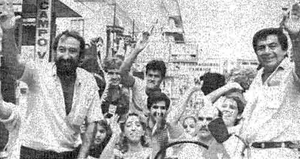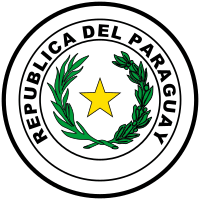1989 Paraguayan coup d'état
The 1989 Paraguayan coup d'état, also known as La Noche de la Candelaria, was a coup d'état that took place on 2–3 February 1989 in Asunción, Paraguay led by General Andrés Rodríguez against the regime of long-time leader Alfredo Stroessner. The bloody overthrow which saw numerous soldiers killed in street fighting was sparked by a power struggle in the highest echelons of the government. Rodríguez's takeover spelled the end of El Stronato, Stroessner's thirty-four year long rule, at the time the longest in Latin America, and led to an array of reforms which abolished numerous draconian laws and led to the liberalization of Paraguay.
| 1989 Paraguayan coup d'état | |||||||
|---|---|---|---|---|---|---|---|
 Demonstration of the Authentic Radical Liberal Party headed by Domingo Laíno (left), the main leader of the opposition to the regime, on 3 February 1989, in support of the overthrow of Stroessner | |||||||
| |||||||
| Belligerents | |||||||
|
|
Supported by: | ||||||
| Commanders and leaders | |||||||
|
|
| ||||||
| Casualties and losses | |||||||
| estimated 31–300 soldiers killed in action | |||||||
Part of a series on the |
|---|
| History of Paraguay |
 |
|
|
Background
Alfredo Stroessner, a general and veteran of the Paraguayan Civil War and the Chaco War, came to power in the aftermath of the 1954 coup d'état. As president he declared a "state of siege" and instituted a number of laws and security reforms which gave him the power to suspend civil liberties, including habeas corpus and freedom of assembly.[1] Between 1958 and 1988, Stroessner was reelected seven times by questionably high margins of victory (only in the 1968 election did an opposition candidate receive more than 20% of the vote).[2] The United States was one of President Stroessner's most ardent supporters, due to his fervent anti-communism and Paraguay was the recipient of large amounts of U.S. military assistance during the 1960s and 1970s.[3][4] The "state of siege" imposed by Stroessner soon after assuming the presidency was officially lifted in 1987; however, this move was largely symbolic as most of the country's stringent security provisions remained in place.[5]
In the late 1980s, political conflict broke out between two competing factions in the ruling Colorado Party. One faction, the "militants", vigorously supported Stroessner while the "traditionalists" sought a more open Paraguay and were less supportive of some of Stroessner's policies. Among the traditionalists was General Andrés Rodríguez, a close confidante of Stroessner and commander of Paraguay's 1st Army Corps. A strong contender for succeeding the aging president, the militant wing of the party attempted to neuter his political power by giving him the option of taking the position of defense minister, a largely ceremonial position, or retiring.[6] Fearing a rebellion, Stroessner had already removed high-ranking, experienced military commanders from their postings and replaced them with cronies.
Coup
On the night of 2 February 1989, Rodríguez ordered units of his 1st Army Corps, including some 40 to 50 tanks, into the streets of Asunción. The unit, the strongest and most well-equipped of Paraguay's armed forces seized the capital city's center. Troops from the unit attempted to arrest Stroessner as he dined at his mistress' home, however bodyguards resisted fiercely and allowed the president to escape to the headquarters of the Presidential Escort Regiment.[7][8] A battle broke out between Rodríguez's troops and the 700-strong presidential guard. Meanwhile, the rest of Paraguay's military districts pledged their allegiance to the rebels.
Artillery units and naval vessels in the city's harbor shelled the headquarters during the course of the battle and by 5:00pm on 3 February, the government under Stroessner surrendered. Rodríguez announced the surrender over the radio and said Stroessner was in custody and unharmed. The official death toll of the coup stood at 31 killed however other estimates put the actual toll between 150 and 250, the majority of them Stroessner's guards.[9] The Catholic Church station Radio Caritas said up to 200 people were killed in the fighting.
Stroessner was initially detained at the base of the 1st Army Corps but he was flown to exile aboard a LAP Boeing 707 to Brasilia, Brazil on 6 February after being granted asylum. He left with his son, Gustavo, and daughter-in-law and lived in a lakeside home, previously his summer home, until his death in 2006.[10][11]
Aftermath
President Andrés Rodríguez began his rule by reversing Stroessner's repressive measures, removing his loyalists from the military, and abolishing the death penalty. He also abolished the legislature, removed the sweeping ban on political parties, and organized elections to take place in May 1989. Rodríguez was elected to the presidency in the 1989 elections and served in that capacity until 1993, the first Paraguayan leader in decades to leave at the end of his first term. He died of cancer in 1997.[12]
See also
References
- Epstein, Jack (2006-08-17). "ALFREDO STROESSNER: 1912-2006 / Dictator controlled Paraguay for 34 years". SFGate. Retrieved 2018-01-23.
- "President Alfredo Stroessner, the longest ruling dictator in Latin..." UPI. 1989-02-03. Retrieved 2018-01-23.
- Frank O. Mora; Jerry Wilson Cooney (October 2010). Paraguay and the United States: Distant Allies. University of Georgia Press. pp. 201–. ISBN 978-0-8203-3898-9.
- Hugh M. Hamill (1 January 1992). Caudillos: Dictators in Spanish America. University of Oklahoma Press. pp. 343–. ISBN 978-0-8061-2428-5.
- "State of siege ends in Paraguay after 33 years". UPI. 1987-04-08. Retrieved 2018-01-23.
- Riding, Alan; Times, Special to the New York (1989-02-04). "Paraguay Coup: Battle for Succession". NYTimes.com. Retrieved 2018-01-23.
- "PARAGUAY CALM AGAIN AFTER MILITARY TAKEOVER". Washington Post. 1989-02-05. Retrieved 2018-01-23.
- Peter Lambert; Andrew Nickson (27 July 2016). The Transition to Democracy in Paraguay. Springer. pp. 68–. ISBN 978-1-349-25767-6.
- Peter Lambert; Andrew Nickson (31 December 2012). The Paraguay Reader: History, Culture, Politics. Duke University Press. pp. 326–. ISBN 0-8223-5268-0.
- "Alfredo Stroessner; Paraguayan Dictator". Washington Post. 2006-08-17. Retrieved 2018-01-23.
- "Ousted Dictator Stroessner Flies to Exile in Brazil". latimes. 1989-02-06. Retrieved 2018-01-23.
- "Andres Rodriguez". The Economist. Retrieved 2018-01-23.
